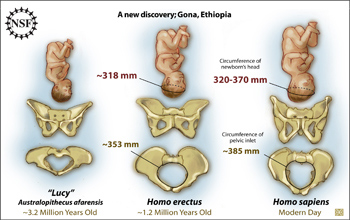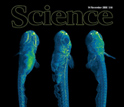|

Press Release 08-203
Discovery Questions Intelligence of Human Ancestor

Pelvis dated to 1.2 million years ago shows our ancestors were born with bigger heads
November 18, 2008
A recently discovered female pelvis is changing minds about the head size of an ancient human ancestor, Homo erectus, and consequently revising notions about how smart they may have been. Found in Gona, Ethiopia, not far from the site that yielded the 3.2 million year old remains of the famed Australopithecus afarensi "Lucy," the pelvis indicates that Homo erectus, which lived in Africa roughly 2 million years ago, had a larger birth canal than originally suspected and could have given birth to babies with bigger brains. Before the female pelvis was found, evidence from the pelvis of a juvenile male led researchers to project that the cranial circumference and capacity of newborn Homo erectus babies was 30 percent smaller than more recent projections based on the newly discovered pelvis. Sileshi Semaw, a paleoanthropologist at the Stone Age Institute and Indiana University-Bloomington, and his colleagues assert that the head of a baby born from this Homo erectus could have been 318 millimeters in circumference. This is at the lower end of the spectrum of modern day human beings whose cranial circumferences at birth typically range from 320-370 millimeters. Semaw and colleagues present their findings in the Nov. 14 issue of Science. The research is funded in part by the National Science Foundation. --Zina Deretsky, NSF
-NSF-

Media Contacts
Bobbie Mixon, NSF (703) 292-8070 bmixon@nsf.gov
Steve Chaplin, Indiana University (812) 856 1896 stjchap@indiana.edu
Program Contacts
Mark L. Weiss, NSF (703) 292-7272 mweiss@nsf.gov
Principal Investigators
Sileshi Semaw, Indiana University (812) 876 0080 ssemaw@indiana.edu

The National Science Foundation (NSF) is an independent federal agency that supports fundamental research and education across all fields of science and engineering. In fiscal year (FY) 2009, its budget is $9.5 billion, which includes $3.0 billion provided through the American Recovery and Reinvestment Act. NSF funds reach all 50 states through grants to over 1,900 universities and institutions. Each year, NSF receives about 44,400 competitive requests for funding, and makes over 11,500 new funding awards. NSF also awards over $400 million in professional and service contracts yearly.
 Get News Updates by Email Get News Updates by Email
Useful NSF Web Sites:
NSF Home Page: http://www.nsf.gov
NSF News: http://www.nsf.gov/news/
For the News Media: http://www.nsf.gov/news/newsroom.jsp
Science and Engineering Statistics: http://www.nsf.gov/statistics/
Awards Searches: http://www.nsf.gov/awardsearch/
| 


